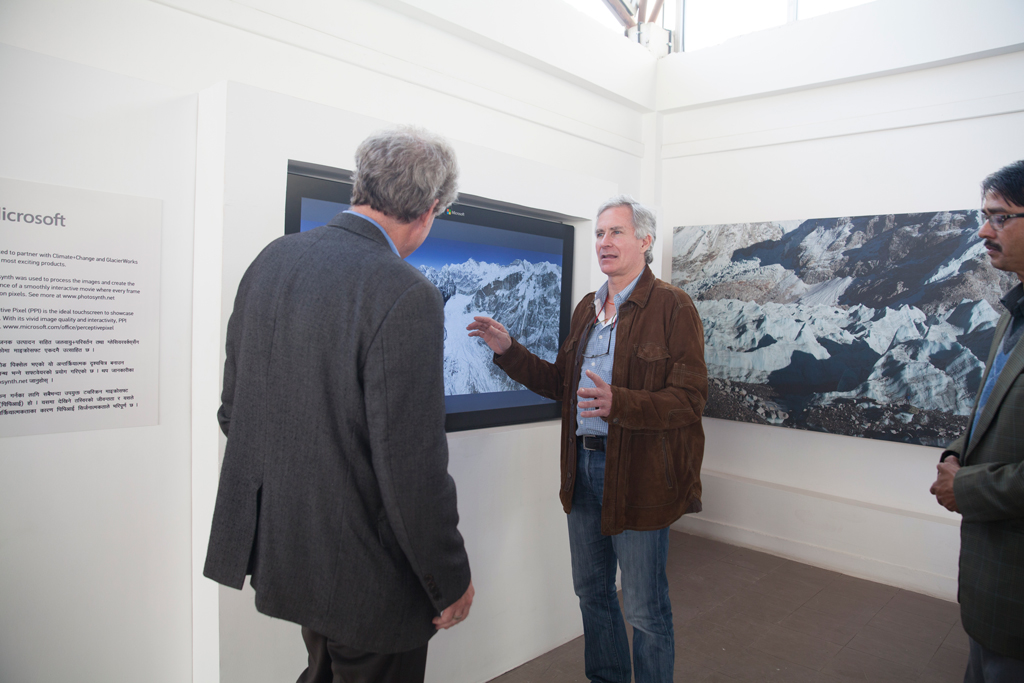Last month saw for the first time the Arctic Circle knit together Earth’s three polar […]
David Breashears in 1985 became the first climber from the USA to reach the summit of Everest more than once; in 1987 led the first guided commercial expedition to the mountain and he summitted the mountain overall five times. But it was not until 2007, when he started to chronicle the impact of temperature rise on Earth’s mountains, that he found his true calling – the work for which he would most like to be remembered, according to his sister.
It was that year that, shooting a film in Solukhumbhu for US network broadcaster PBS, Breashears first took a photograph of the North Face of Everest in the exact spot, at the exact time of day, and in the exact same season, that British explorer George Mallory had taken the first ever photograph of glacier and mountain 90 years before.
Overlaying his own exact replica of that first image over the original revealed the true extent of the ice that had already been lost over the past century. Even all those years ago, much of Everest’s own ice cap was already gone, and the main glacier had shrunk dramatically.
“This was when I understood the actual magnitude of what climate change was doing to the mountains, and I wanted to start a dialogue about what is happening in the Himalaya,” he told the Nepali Times in 2013.
He started to dedicate his life to chronicling these changes using photography: not just those photos based on Mallory’s collection from the Royal Geographical Society in London, but also using Erwin Schneiders’s images from the 1950s, of Imja Glacier.
“Deep in my heart when I see this landscape I think there is a problem, and I think people should know about it,” he’d told author, editor and personal friend, Lisa Choegyal, who served on the board of GlacierWorks, Breashears's climate communications organisation.
“His powerful, pioneering shrinking glacier images and touch-screen innovations were way ahead of their time in calling the world’s attention to the threatened state of our planet,” she said at a tribute in Kathmandu last month.


Breashears was one of a number of climbers whose careers in the mountains have given them a front-row eyewitness view of the shocking extent of ice and snow losses in Earth’s frozen zones.
“Those of us who have climbed Everest for the past 33 years have seen the changes taking place under our own feet," he told the Nepali Times in 2013. "The traverse to the Hillary Step from the South Summit were almost entirely snow climbs. Now our crampons scrape and scratch across exposed rock… the snow arête no longer exists.”
The vast images he produced, which he worked with ICIMOD to create and exhibit, had an extraordinary impact on general publics, and are still considered the organisation’s communications high-water mark.
Dr Joseph Shea, an ICIMOD alumnus who is now an associate professor at the University of Northern British Columbia said, “Everyone who walked into the room was blown away.” Crucially, the show cut through to an extraordinarily diverse cross-section of society: from schoolchild, to rickshaw-driver, to ambassador.
These included those that had never seen mountain snow, and who were able to see with their own eyes the changes in the cryosphere through his images, and to join the dots between those losses and water availability for crops, or hazards downstream.
Amy Sellmyer, senior editor at ICIMOD at the time of the exhibition, said Breashears understood how important it was to make people fall in love with the mountains first – and so always led with their sheer spellbinding beauty. She said he also grasped “before most of us did how important it was for people to be able to see the changes with their own eyes.”
David Molden, then ICIMOD Director General, said the show also gave people a space to come together and talk about other environmental issues beyond the cryosphere too – about air pollution, plastic waste, the Bagmati river. It sparked a national conversation.
The project also transformed his collaborators' notion of what they were capable of achieving.
As Sellmyer said: “He pushed us to go way beyond what any of us really thought was possible, truly expanded our sense of what we might do. He showed us a different way to tell our story, and the power of doing so.”
“You’d talk to him and think, well, that’s an impossible task,” Molden continued. “But he’d keep pushing and pushing and gather enough allies and all of a sudden, the seemingly impossible had happened. It was so special to have had the opportunity to work with him. And I’m so very glad he chose to work with ICIMOD. He helped our work beyond measure.”
Given how far off countries are from delivering rapid and deep emissions reductions, and how quickly now the cryosphere is disappearing, in the Hindu Kush Himalaya and around the world, his work takes on even greater poignancy.
Jakob Steiner, an ICIMOD alumnus who is now based in Pakistan as a fellow of the Himalaya Universities Consortium and an author of ICIMOD's landmark Water Ice Society and Ecosystems in the Hindu Kush Himalaya (2023) report, said: “Himalayan landscapes are changing so rapidly, we can hardly keep up documenting what we lose. David documented mountain vistas, of glaciers and snow that are already now gone, visualising this speed of loss. His work reminds us how important it is to capture this, so next generations can understand what could have been”, he said.
Breashears’s work has earned its place within an invaluable visual archive – alongside photographers working before he was even born: an archive that scientists are using to build a timeline of change for tomorrow’s climbers, filmmakers, and activists.
Bob Palais, Breashears’s friend and a research professor at the University of Utah in the USA said he and colleagues “shared our sense of loss and appreciation for someone who had worked so hard to advance awareness of the very present and even greater future harms that exceedingly rapid global climate change portends.”
Palais went on to talk about what it was about the mountains, beyond David’s sheer mountaineering artistry, that he thought kept David coming back year after year after year, whether to the Himalayas or to Colorado. It was the mountain peoples, Palais thought, that kept him rapt – and his reverence for the cultures of reciprocity found among those who lived in such proximity to unique and fragile lifeforms created through thousands of years of complex processes in these steep, remote zones.
“I think all of us working in the mountains should strive to have that same passion about what’s happening in the Himalaya as David had,” Molden said. “His dedication to this region provides inspiration and guidance and leadership on how to do that.”
While Breashears was clearly a completely unique, idiosyncratic, indefatigable one-off, for more of us to pick up his work, or to carry even just a shred of his ambition, vision, determination and urgency – and scientific rigour – forward into our own spheres of work, using our own individual talents, is, of course, more urgent now than ever.
#SaveOurSnow



